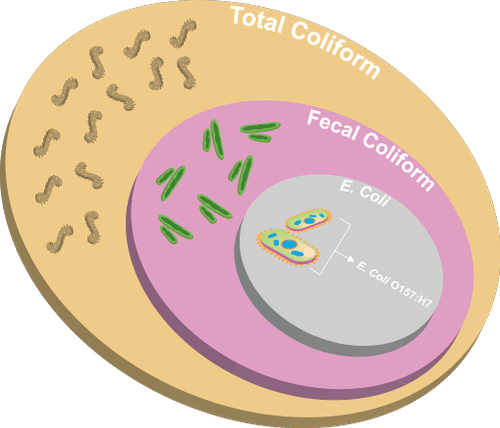Water quality advisories issued by the Province of Alberta, as a measure to protect public health and safety, often quote elevated levels of fecal coliforms as the main reason to avoid contact with the water body for which the advisory has been issued.
Advisories warn water users not to swim in or drink the water due to a list of potential negative effects from exposure to water-borne organisms, including fecal coliforms. Based on this information, which contains few details on the organisms themselves, it is a reasonable conclusion that fecal coliforms are harmful and any water with a fecal coliform warning poses a serious health risk.
That said, there is more to the science and people often raise questions to better understand the risks like: How serious is the risk from coliforms? Are certain coliforms more harmful than others? Does boiling water completely remove the risk? Is all E. coli toxic?
Coliforms are a collection of bacteria that includes fecal coliforms. They originate from animal digestive tracts, animal waste, and other natural and man-made decomposition processes (e.g., waste treatment). Fecal coliforms occur naturally in the lower digestive tract, but can be harmful under certain exposure situations.
Various types of coliforms are used as indicators of microbial contamination in water in the following ways:

Figure 1: Relationship between total coliform group, fecal coliform group, and E. coli.
Adapted from Verhille, S. (2013) Understanding microbial indicators for drinking water assessment (Figure 1).
Not all fecal coliforms themselves are considered pathogenic, or disease-causing, however the routine methods for analysing coliforms cannot easily discern between harmful and benign species.
In cases where fecal contamination has caused serious illness it is due to the presence of pathogenic strains of bacteria, such as E. coli 0157:H7, which was the culprit in a Walkerton tainted water case in Ontario.
The real issue is that water containing fecal coliforms may have been in contact with fecal matter, which increases the risk of it containing other bacteria, viruses and enteric protozoa.
These disease-causing organisms, such as pathogenic strains of E. coli, Salmonella, Giardia and Cryptosporidium (see Microorganisms and Pristine Headwaters ) and many other microbes are the real concern when there is potential or confirmed contamination of water with feces.
Since there is no single, common microbial indicator that can represent all potential pathogens, casting a wide net for fecal coliforms provides an opportunity to flag water that is potentially contaminated and needs to be treated with additional processes before consumption.
The Environmental Public Health Department of Alberta Health Services is responsible for sampling and inspecting public water supplies, as well as issuing water advisories when required.
This department checks specifically for E. coli and total coliform bacteria in drinking water through the Provincial Laboratory of Public Health, Environmental Microbiology Services. Alberta Environment and Parks (AEP) is responsible for monitoring water quality of lakes and reservoirs, and will issue advisories for fecal coliforms through Alberta Health Services.
Checking with AHS for active Health Advisories is a simple way to decrease the risk of illness from contact with contaminated water. The advisories specify what activities are not recommended and for which water body, and always prioritize public health and safety.
Although the Government of Alberta monitors for fecal coliforms in lakes and reservoirs, there are too many for each one to be tested frequently enough to guarantee that no contamination exists. Water quality data and sampling locations are stored in AEP’s central Water Data System, which can be accessed through the Alberta Environment and Parks website.
Direct consumption of contaminated water used for drinking or cooking presents the highest potential risk to human health, therefore a good rule of thumb is to assume that all surface water is unsafe to drink without prior treatment. There are numerous treatment methods, such as boiling, UV disinfection, chemical disinfection, and filtration, that are all useful for different types of pathogens and potential contaminants.
Alberta Health Services. (2016). Contaminated water advisory extended for Elbow River (within the city of Calgary). Retrieved May 5, 2017, Retrieved from http://www.albertahealthservices.ca/news/Page13290.aspx
British Columbia Ground Water Association. (2007). Total, Fecal and E. coli Bacteria in Groundwater. Water Stewardship Information Series (February). Retrieved from http://www.env.gov.bc.ca/wsd/plan_protect_sustain/groundwater/library/ground_fact_sheets/pdfs/coliform(020715)_fin2.pdf
Environment Canada. (2001). Threats to Sources of Drinking Water and Aquatic Ecosystem Health in Canada. NWRI Scientific Assessment Report Series No. 1. Retrieved from http://publications.gc.ca/collections/Collection/En40-237-1-2001E.pdf
Health Canada. (2008). What’s in Your Well? – A Guide to Well Water Treatment and Maintenance. Retrieved May 5, 2017, Retrieved from https://www.canada.ca/en/health-canada/services/environmental-workplace-health/reports-publications/water-quality/what-your-well-guide-well-water-treatment-maintenance.html
Inside Walkerton: Canada’s worst-ever E. coli contamination – Canada – CBC News. (2010). Retrieved October 24, 2017, from http://www.cbc.ca/news/canada/inside-walkerton-canada-s-worst-ever-e-coli-contamination-1.887200
New York State Department of Health. (2012). Coliform Bacteria in Drinking Water Supplies. Retrieved from https://www.health.ny.gov/environmental/water/drinking/coliform_bacteria.htm
Verhille, S. (2013). Understanding microbial indicators for drinking water assessment: interpretation of test results and public health significance. NCCEH Reviews, (Figure 1), 1–12. Retrieved from http://www.ncceh.ca/documents/guide/understanding-microbial-indicators-drinking-water-assessment-revised
We provide Canadian educational resources on water practices to promote conservation and sustainability. Our team crafts current and relevant content, while encouraging feedback and engagement.
The Canada WaterPortal is a registered charity, #807121876RR0001
We recognize and respect the sovereignty of the Indigenous Peoples and communities on whose land our work takes place.
© 2025 All Rights Reserved.